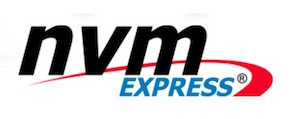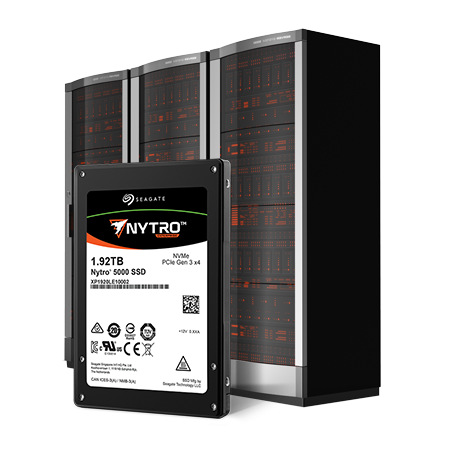An optimally-running data center must have a storage protocol (a standard for storage software, features and so on) and a hardware interface that is developed and tuned for the media device. Such is the case with SAS and SATA, the two key point-to-point serial protocols that move data to and from computer-storage devices like hard drives and tape drives.
For years, SAS and SATA were the go-to standards for data centers. Because of this, enterprise SSDs were initially equipped to support the SAS and SATA protocols, and these SSDs continue to be widely accepted and used by enterprise data centers everywhere for their performance and value.
However, these solutions also come with the overhead of SAS and SATA command translation layers and bandwidth challenges in supporting the performance demands of applications using SSDs. With the increasing deployments of SSD technology in enterprise environments, a new combination of a protocol standard and an interface were called for.
 For NAND-based enterprise SSDs, the ideal protocol and interface combination did not exist until less than a decade ago. This is when the Non-Volatile Memory express (NVMe™) technology standard coupled with a Peripheral Component Interconnect express (PCIe) interface first appeared. Often you’ll see these terms used interchangeably — for example, “NVMe SSDs” or “PCIe SSDs” — as they’re both necessary together for SSDs to achieve their full potential.
For NAND-based enterprise SSDs, the ideal protocol and interface combination did not exist until less than a decade ago. This is when the Non-Volatile Memory express (NVMe™) technology standard coupled with a Peripheral Component Interconnect express (PCIe) interface first appeared. Often you’ll see these terms used interchangeably — for example, “NVMe SSDs” or “PCIe SSDs” — as they’re both necessary together for SSDs to achieve their full potential.
To clear the air on how these two technologies are collaboratively driving this new and growing SSD market, let’s review each of them separately.
What are the benefits of the NVMe standard?
The NVMe standard is built on a fundamentally different approach, which is fueling how follow-on generations of products are coming to realization. Its development has gone beyond defining an interface from a hardware and software perspective.
NVMe is the first interface specification to take full advantage of an SSD’s strengths and potential. Further, NVMe defines new usage modes and data types, such as: borrowing memory from the system, creating new semantics, integrating with the network, and so on.
NVMe comes with a standard driver for ease of use, and provides a high-bandwidth and low-latency framework for SSDs. NVMe’s success is primarily due to the removal of translating commands that would normally occur in the SATA or SSD controller.
In a nutshell, NVMe, with its specification advancements, removes these controllers’ latency and software latency. NVMe can double — and sometimes triple — sequential throughput rates by eliminating processing times and the constricting SATA or SAS pipeline.
 Although the NVMe standard has been around for almost a decade, wide adoption didn’t take off until 2012 when data center hardware began to develop specs that supported NVMe and a range of supporting form factors. This includes U.2, also referred to as the 2.5-inch form factor, and M.2, often called the “Gum Stick” form factor. Seagate offers both of these form factors with our Nytro® 5000 NVMe SSDs. In addition M.2s can be placed on an add-in card (AIC) to accommodate existing hardware PCIe slots, as with Seagate’s Nytro 5910 NVMe SSD.
Although the NVMe standard has been around for almost a decade, wide adoption didn’t take off until 2012 when data center hardware began to develop specs that supported NVMe and a range of supporting form factors. This includes U.2, also referred to as the 2.5-inch form factor, and M.2, often called the “Gum Stick” form factor. Seagate offers both of these form factors with our Nytro® 5000 NVMe SSDs. In addition M.2s can be placed on an add-in card (AIC) to accommodate existing hardware PCIe slots, as with Seagate’s Nytro 5910 NVMe SSD.
Now that NVMe has the support of a range of equipment, such as servers, enterprise storage devices, mobile phones and so on, NVMe has made its mark and is here to stay.
Another performance and scale feature of the NVMe spec is Multitenant and Multiple queues, which support a large number of deep queues and commands per queue. These capabilities drove expanded NVMe adoption when hyperscale environments took off. These new scale-out architectures mean NVMe has clear advantages in highly scalable deployments. The SCSI bottleneck of middle-layer translations struggled to support simultaneous IOs and multiple hosts, making SAS difficult to expand effectively. NVMe, on the other hand, with these Multienant and Multiple queues features, removes the bottleneck and seamlessly supports these environments.
What does PCIe have to do with NVMe?
PCIe is the high-bandwidth bus technology that provides the ideal match with NVMe. Before the PCIe-NVMe partnership, SSDs relied on SAS and SATA protocols, and they couldn’t realize their full performance attributes. The PCIe interface enables the increased performance of NVMe by eliminating the SCSI command stacks and direct-attached storage (DAS) bottlenecks associated with SAS and SATA. This highly scalable interface flows in parallel along each available PCIe lane. In a four-lane PCIe 3.0 connection, for example, where each lane offers 8Gb/s of bandwidth, raw bandwidth is nearly 4GB/s.
“It just works,” the phrase coined by Apple, applies to the NVMe-over-PCIe technologies as well. Together, NVMe and PCIe are driving many of the high-performing and hyperscale environments of today.
Technology leaders partner in the NVM Express standards workgroup
Seagate participates across various units in the NVMe standards organization, NVM Express, Inc., to influence the design, roadmap development and adoption of NVMe. This cohesive group drives the standard into the marketplace, and Seagate takes our role seriously in leading the charge to ensure the highest quality solutions and to revolutionize the data center.
With any technical standard such as NVMe, device interoperability is one of the key objectives Seagate strives for, so our involvement in NVM Express educational activities and plugfests is crucial.
“Early specification compliancy and interoperability is paramount to Seagate and our customers ensuring the robustness of our NVMe solutions,” says JB Baker, senior director of SSD products at Seagate. “Secondly, this testing often validates the effectiveness of the standard that has been developed, and provides the end customer a seamless solution.”
Enabling full SSD performance for hyperscale architectures
NVMe gives customers the full performance and low-latency potential of SSDs, and is driving the success of new deployments with hyperscale and file storage solutions as well as driving new industries which require this massive scale and performance from the Internet of Things, data mapping and the Cloud.
The data technology industry is quickly ramping up adoption of NVMe, making the availability of an open and collaborative standard critical. NVMe not only serves high-end enterprise storage, but also services client and mobile solutions, and continues to demonstrate that it will be a key technology for industry success. While other standards have great value in their own right, NVMe helps Seagate create new features and solutions that did not exist before. This is innovation at its finest. We are looking forward to continuing advancements and contributions to this standard, with the key focus of delivering excellent solutions to our customers.







